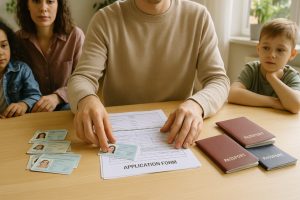Are you facing danger, persecution, or fear in your home country and wondering if Canada could be your safe haven? For many, seeking asylum in Canada offers the possibility of rebuilding life in a country that respects human rights and offers protection to those in need.
Claiming refugee status means requesting Canada’s legal protection because you cannot return home safely. Whether you’re already in Canada or just arriving at a port of entry, understanding the asylum process is essential to protect your future.
This guide will walk you through every step of how to claim refugee status in Canada, from eligibility and procedures to your rights while waiting. By understanding the legal process, requirements, and what to expect, you can be better prepared to take the next steps toward a safe and stable life in Canada.
What Does Claiming Refugee Status in Canada Mean?

Claiming refugee status in Canada means asking the government to grant you protection because returning to your home country could put your life, safety, or freedom at serious risk. Refugee protection is available to people who cannot return to their home country due to threats such as persecution, torture, or cruel treatment.
There are two main paths through which refugee protection can be claimed in Canada. The first is making an asylum claim from inside Canada.
The second is applying for resettlement as a refugee from outside Canada, usually through referral by the United Nations Refugee Agency (UNHCR) or a private sponsor. However, this guide focuses on those who are seeking protection while already in or entering Canada.
Refugee claimants must demonstrate that they are either Convention refugees or persons in need of protection. A Convention refugee is someone at risk because of race, religion, nationality, political opinion, or membership in a specific social group.
In contrast, a person in need of protection faces serious risks such as torture or violence upon return. Understanding this foundation helps you determine whether applying for refugee protection is appropriate for your situation.
Who Can Apply for Refugee Protection in Canada?
Not everyone can qualify for refugee protection in Canada. The process is meant for individuals with a well-founded fear of harm and not as a means to extend a stay or work permit.
You may apply if you:
- Face persecution due to race, religion, political opinion, nationality, or social group
- Are at risk of torture or cruel, inhumane treatment
- Face threats to your life if returned to your country
- Are stateless and cannot safely return to your usual country of residence
But even if your reasons qualify, your claim may be ineligible if:
- You’ve already been granted refugee status by another country
- You have a pending or rejected claim in Canada
- You’re inadmissible to Canada due to criminal acts or human rights violations
- You entered Canada from the US and don’t meet the Safe Third Country Agreement exceptions
Once you apply, Immigration, Refugees and Citizenship Canada (IRCC) will assess your eligibility. If accepted, your claim will be referred to the Immigration and Refugee Board of Canada (IRB). If found ineligible, you will be referred to the Canada Border Services Agency (CBSA) for possible removal.
Understanding who can apply ensures your time, energy, and safety are directed appropriately toward a legitimate claim.
How Can You Claim Refugee Protection at the Canadian Border?

If you arrive in Canada at a border entry and need protection, you can submit a refugee claim right there. This process applies to airports, seaports, or land borders and is legally considered a claim made from within Canada.
Making a Claim at a Port of Entry (Airport, Seaport, Land Border)
When you arrive, inform the CBSA officer that you want to make a refugee claim. This step initiates the process. The officer will check your eligibility and provide you with forms and instructions to move forward. This is commonly referred to as a port-of-entry claim and is different from applying online from within Canada.
What Documents Do You Need?
You should be ready to present identification and travel documents such as:
- Passport or travel documents
- Proof of identity or nationality
- Any records showing risk or harm in your home country
- Optional evidence, like political membership cards or police reports
If you don’t have some of these, explain why. The process still continues as long as your explanation is deemed reasonable.
Border Interview and First Steps
At the port of entry, you’ll be interviewed by a CBSA officer. This involves questions about your background, why you fled your country, and why you’re claiming asylum.
Your fingerprints and photographs will also be taken. If your claim is found eligible, it will be referred to the IRB. If not, CBSA may issue a removal order. The start of your protection journey begins here, so clarity and honesty are essential.
Can You Claim Asylum from Inside Canada?
If you are already in Canada and fear returning to your home country, you can make an asylum claim online through IRCC. This process is known as an inland refugee claim.
To be eligible, you must meet the criteria under international and Canadian refugee laws. You cannot apply if you’ve already claimed asylum in Canada and been rejected, withdrawn, or abandoned that claim. You also cannot apply if you are already protected under Canadian law or entered through a safe third country like the US without meeting an exception.
Your claim must include reasons for your fear, supported by evidence when possible. You will also need to provide identification documents and a completed Basis of Claim (BOC) form. If your claim is accepted as eligible, it moves forward to the IRB for assessment.
Applying from within Canada gives you time to prepare and gather the necessary documentation. It also allows you to remain in the country during the evaluation process.
What Are the Steps to Submit a Refugee Claim Online?

Making a refugee claim online from inside Canada is a structured process. You must use the IRCC Portal to submit your documents, verify your eligibility, and wait for IRB’s review.
Step 1: Create an IRCC Portal account
Visit the IRCC Portal and request an invitation code using your email address. Once received, use it to set up your account. This portal allows you to manage the entire process, including claims for your family members.
Step 2: Upload documents and complete the claim
Before you start, gather the required documents including:
- Your passport or ID
- Basis of Claim (BOC) form
- Medical and police reports (if applicable)
- Proof of entry into Canada
- Any supporting evidence for your claim
Upload all files in PDF or image format and double-check completeness before submitting. Be transparent if you’re unable to provide a document.
Step 3: Submit and receive Acknowledgment of Claim
After submission, you’ll receive an Acknowledgment of Claim letter from IRCC. This includes instructions for a medical exam and a scheduled interview. At the in-person appointment, your identity and documents will be verified.
Your biometrics (fingerprints and photo) will be collected. If approved, your case moves to the IRB. If ineligible, CBSA is notified for further action. Starting your claim online ensures your process is official and tracked, allowing you to access services while waiting for the decision.
What Happens After You Submit Your Refugee Claim?
Once your refugee claim is submitted, IRCC assesses whether it’s eligible. If it is, you’ll be referred to the Immigration and Refugee Board (IRB) for a hearing.
Here’s what you can expect:
- A confirmation letter (Acknowledgment of Claim)
- Instructions for your medical exam
- Interview appointment date
During your in-person interview, you and any family members included in the claim will need to bring:
- Passports and ID
- Any other supporting documents
The officer will ask about your background, country of origin, and the risks you face. Your biometrics will be collected, and your travel documents will be held until a final decision is made.
If your claim passes eligibility, IRCC will forward it to the IRB for review. If not, the CBSA will initiate removal steps. It’s important to be thorough, truthful, and timely in this phase.
What Happens at the Refugee Hearing?

The IRB refugee hearing is where you’ll have the opportunity to present your case in detail. A tribunal member will evaluate your claim based on your evidence and testimony.
You must prove that you are either:
- A Convention refugee (persecuted due to identity, belief, or social group), or
- A person in need of protection (risk of torture or life-threatening harm)
During the hearing:
- You can bring legal representation
- You will be asked questions about your background and claim
- Your credibility and documents will be assessed
If accepted, you receive protected person status and can apply for permanent residency. If rejected, you may be ordered to leave Canada unless an appeal or other legal option is available. Being prepared with evidence and a clear narrative helps strengthen your position in the hearing.
Can You Work or Study While Waiting for a Decision?
Yes, while your refugee claim is being processed, you may have the right to work and study in Canada. These temporary rights help asylum seekers live and support themselves.
To work:
- Indicate your intent to work during your claim submission
- If eligible, you’ll be issued an open work permit
- A valid medical exam is required
- You must apply for a Social Insurance Number (SIN) once approved
To study:
- Children can attend school without a study permit
- Adults must apply for a study permit online
- Proof of acceptance from a designated learning institution is required
- Study permits must be extended before they expire
Accessing work and education ensures that you can support yourself and integrate into Canadian society while waiting for the final decision.
What is the Safe Third Country Agreement and How Can It Affect Your Claim?
If you’re entering Canada from the United States, the Safe Third Country Agreement (STCA) plays a major role in your eligibility for claiming asylum. This agreement assumes both countries are safe for refugees, and thus restricts claims made at land borders.
Explanation of the STCA
Under the STCA, you cannot claim asylum in Canada if you arrive at an official US-Canada land border crossing unless you meet certain exceptions.
Land Border Restrictions and Exceptions
You may still be eligible if:
- You have family in Canada
- You are an unaccompanied minor
- You have valid Canadian documents (visa, permit)
- You are facing the death penalty in the US
If none of these apply, you may be returned to the US.
What to Do if Entering From the US?
Avoid entering irregularly. Use legal options and check if you qualify for any STCA exceptions. If you cross into Canada and make a claim within 14 days of entry, STCA may still apply and result in removal.
Knowing how the STCA works helps you avoid automatic rejection and supports your chance of success.
What Documents Do You Need to Claim Refugee Status?

Submitting the right documents is crucial for a successful refugee claim in Canada. These documents prove your identity, your presence in Canada, and the risk you face if returned home.
Required documents include:
- Passport or national ID
- Basis of Claim (BOC) form
- Travel documents
- Use of a Representative form (if applicable)
Optional but helpful documents include:
- Medical reports
- Police certificates
- Proof of political affiliation
- Evidence of threats or violence
- News articles or court records
Table: Common Documents and Their Purpose
| Document Type | Purpose | Required |
| Passport/ID | Prove identity | Yes |
| BOC Form | State claim details | Yes |
| Police or Medical Report | Support claims of harm or trauma | Optional |
| Entry Proof | Show when/how you entered Canada | Optional |
| Political Evidence | Show persecution for beliefs or roles | Optional |
Prepare and submit as many relevant documents as you can. The more evidence you provide, the stronger your case will be.
What Happens If Your Refugee Claim Is Rejected?
If your claim is denied by the IRB, it means they did not find enough evidence that you are a refugee or in need of protection.
You may then:
- Be asked to leave Canada voluntarily
- Receive a removal order from CBSA
- Lose the right to work or study
However, in some cases, you may be able to:
- Appeal to the Refugee Appeal Division (RAD)
- File for judicial review at the Federal Court
- Apply for a Pre-Removal Risk Assessment (PRRA)
Abandoning or withdrawing your claim can also disqualify you from applying in the future. Always speak to a legal advisor if your claim is refused.
Can You Apply for Permanent Residency After a Successful Refugee Claim?
Yes, once you are granted protected person status in Canada, you can apply for permanent residency.
To be eligible:
- Your refugee claim must be accepted by the IRB
- You must pass all medical, criminal, and background checks
You can also:
- Sponsor immediate family members
- Access settlement services and supports
- Transition to full permanent resident status within months
Becoming a permanent resident opens the door to long-term stability, legal rights, and eventually, Canadian citizenship.
Conclusion
Understanding how to claim refugee status in Canada is essential for those facing real danger and seeking a safe and lawful future. Whether you apply at a border or from inside the country, following the correct steps and providing strong evidence is critical to success.
This guide has walked you through the entire journey, from eligibility and application to hearings, rights, and possible outcomes. Canada remains committed to protecting those genuinely at risk. If this applies to you, take the first step with confidence and honesty.
FAQs
Can I work while my refugee claim is being processed?
Yes, if your claim is eligible, you may receive an open work permit and apply for a Social Insurance Number.
Can I study in Canada while waiting for my refugee decision?
Yes, children can attend school freely, and adults can apply for a study permit once their claim is submitted.
What happens if I lose my refugee ID document?
You can apply to replace your refugee protection identity document through IRCC while waiting for your claim result.
Can I include my family in my refugee claim?
Yes, you can submit one claim through the IRCC Portal and include all immediate family members.
What if I don’t have all the required documents?
You can still submit your claim but must explain why certain documents are missing and provide alternatives if possible.
How long does it take to process a refugee claim?
It varies, but the process can take several months, including the time to prepare for and attend your hearing.
Can I be removed from Canada while my claim is in process?
If your claim is accepted as eligible, you cannot be removed until the IRB makes a final decision.
Recent Posts




